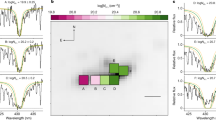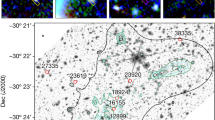Abstract
THE origin of the absorption lines in QSOs, with Zabs ≪ Zem has remained a puzzle. It has been suggested that they result from intervening matter lying along the line of sight but not associated with the QSO1,2. It has also been suggested that the absorption lines arise ‘locally’ from matter expelled from the QSO core3–6. In particular, radiation pressure has been proposed as the driving mechanism3–5. It has, however, been shown that the final velocities required by the expelled matter (vf ∼ c) for Zabs to be ≪ Zem, cannot be attained by radiation pressure7. Alternatively, matter could be accelerated to velocities Vf ∼ c by free electron scattering in the outer region of the QSO core7.
This is a preview of subscription content, access via your institution
Access options
Subscribe to this journal
Receive 51 print issues and online access
$199.00 per year
only $3.90 per issue
Buy this article
- Purchase on Springer Link
- Instant access to full article PDF
Prices may be subject to local taxes which are calculated during checkout
Similar content being viewed by others
References
Bahcall, J. N., and Salpeter, E. E., Astrophys. J., 144, 847 (1966).
Bahcall, J. N., and Spitzer, L., Astrophys. J. Lett., 156, L63 (1969).
Scargle, J. D., Caroff, L. F., and Noerdlinger, P. D., Astrophys. J. Lett., 161, L115 (1970).
Mushotsky, R. F., Solomon, P. M., and Strittmatter, P. A., Astrophys. J., 174, 7 (1972).
Scargle, J. D., Astrophys. J., 179, 705 (1973).
Rees, M., Astrophys. J. Lett., 160, L29 (1970).
Opher, R., Astrophys. J., 187, 5 (1974).
Cohen, J. G., Nature, 237, 273 (1972).
Lawrence, J. L., Morton, D. C., Zucchino, P., Oke, J. B., and Schmidt, M., Astrophys. J., 171, 233 (1972).
Bahcall, J. N., and Goldsmith, S., ibid., 170, 17 (1971).
Bahcall, J. N., Osmer, P. S., and Schmidt, M., Astrophys. J. Lett., 156 L1
Lynds, R., ibid., 164, L73 (1971).
Morton, D. C., and Morton, W. A., Astrophys. J., 174, 237 (1972).
Burbridge, E. M., and Chan, Y. M. T., ibid., 167, 213 (1971).
Brown, R. L., and Roberts, M. S., Astrophys. J. Lett., 184, L7 (1973).
Bethe, H. A., Annln. Phys., 5, 325 (1930).
Reynolds, H. K., Dunbar, D. N. F., Wengel, W. A., and Whaling, W., Phys. Rev., 92, 742 (1953).
Phillips, J. A., ibid., 90, 532 (1953).
Weyl, P. K., ibid., 91, 289 (1953).
Brolley, J. E., and Ribe, F. L., ibid., 98, 112 (1955).
Burbridge, E. M., and Chan, Y. W. T., Astrophys. J., 167, 213 (1971).
Author information
Authors and Affiliations
Rights and permissions
About this article
Cite this article
OPHER, R. Origin of QSO absorption lines. Nature 250, 310–311 (1974). https://doi.org/10.1038/250310a0
Received:
Revised:
Issue Date:
DOI: https://doi.org/10.1038/250310a0
Comments
By submitting a comment you agree to abide by our Terms and Community Guidelines. If you find something abusive or that does not comply with our terms or guidelines please flag it as inappropriate.



